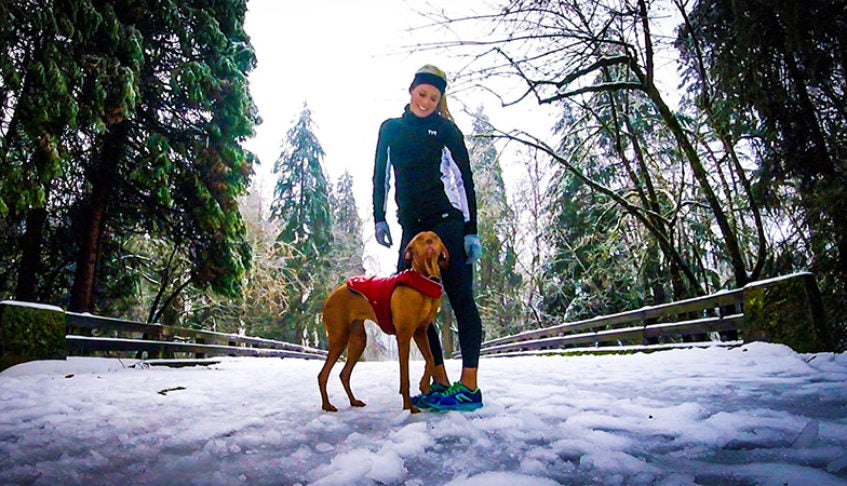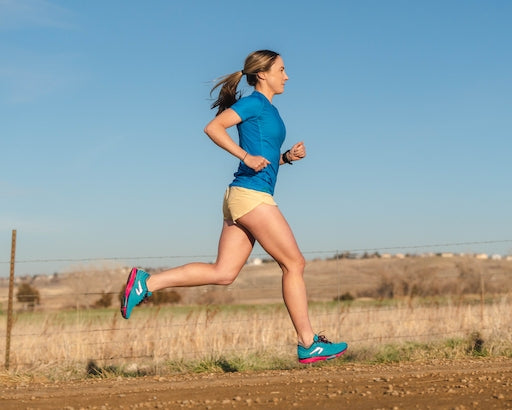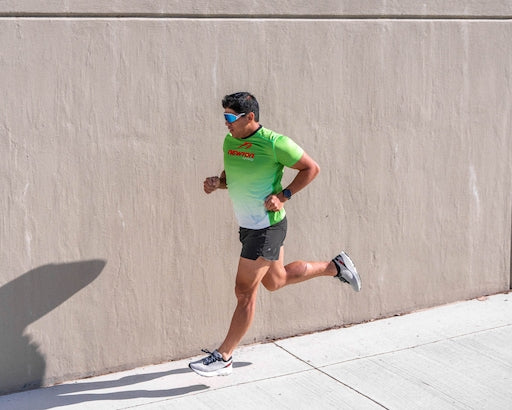
Cold Weather Running Tips
newton running athletes14 October 2019
By: Mackenzie Madison, M.S. Exercise Physiology, USAT Level I Coach and Newton Running Athlete
The beauty of endurance running is that for the most part you can virtually run anywhere in the world, in any weather. As runners we typically correlate our training periods to the seasons: winter is base, spring is speed with 5k’s and 10ks, summer brings half marathon’s and we end our season in the fall a.k.a. marathon and cross-country season. Now that the 2017 winter is upon us, here are some tips from a “seasoned” (pun intended) pro on how to get the most out of your winter training.
- Try to adjust your training schedule. It is the coldest (and dark) in the early morning hours in which many runners train. Temperatures rise throughout the day from the sun and start to plummet again in the evening once dark. Try to shift your training to over the lunch hour if you can. If you go into work earlier, take that extra time over your lunch break to get that run in! It’s safer in daylight as you will be able to see obstacles, avoid icy patches and others such as cars will be able to see you. Your body will also thank you for being able to exercise in warmer temperatures.
- Ditch the speed work. We all know that sprinters hate the cold and for good reason. Our body’s ability to have powerful muscular contractions decreases with decreasing temperature. Our body functions at an optimum temperature level- too cold or too hot and we see performance decreases, not to mention the exponential increase in injury associated with cold weather speed sessions. Trying to add speed on top of tip-toeing your way over an icy patch or worse- not knowing its there and slamming to the ground doesn’t sound like a great, quality speed session. Best to save the speed work for warmer days and inside.
- Layer right. Layering is the most important principle to consider when gathering the right running apparel. The goal is to cover exposed skin, but to also create separate air pockets so that the outdoor cold elements do not adhere to our bodies and clothing. Layering with your base layer wicks up your sweat. The next layer is either an additional long-sleeve warming to protect the wet layer from hitting the cold and cooling you down too much or to create an additional barrier under an outer jacket that protects from wind. IF you live in a windy area get a Gortex material outer jacket or a fabric that creates wind-stopping resistance. All of your base layers need to be moisture wicking to prevent your clothing from getting too damp and causing the body to chill. Your socks should be moisture wicking as well such as wool running socks. Avoid cotton running apparel at all costs as it is the worst type of material to wear- especially in the winter. Dress as if it is 20 degrees warmer outside when considering your running layers. This should prevent overdressing. Most importantly wear some colored materials so you will be seen. Winter is not a time individuals see runners as much so make sure to be seen to be safe. Chances are most of you aren’t going to be able to run over the lunch hour so running early in the morning or at night after work can create a tremendous risk for drivers not being able to see you. Wear a headlamp or carry a flashlight and wear protective gear.
- Winterize your shoes. Winter brings snow and ice and in general can create a lot more moisture on the ground. Start by taking more measures to waterproof your shoes. Perhaps get a specific water-repellent shoe for your winter training to keep your feet warm and happy and running for miles. My favorite tried and true trail and winter running shoe is the Boco Sol. Also consider ordering a half a size up if you intend on wearing thicker moisture-wicking wool socks as well. Not just Cars can hydroplane and skid on ice, so can you! To prevent skidding and sliding and even worse- wiping out get yourself a pair of yak tracks or some DIY hexagonal screw spikes to prevent being victim to the ice.
- Plan your route. What was once your easy, go-to route in the summer may no longer be so easy, you will most likely have to alter your training routes. Rule of thumb is to avoid running in the shade or covered areas as they pose the biggest threat of uneven ground, objects, ice and water puddles. When running in the winter, I suggest you focus on trail routes that have less traffic. Try to run in loops, as it is very beneficial in extreme weather conditions- cold or hot. Running in loops during the winter allows you to take off extra items of clothing if you get too hot or to stop if it’s downright too cold to run. By running in loops, this will also give you access to hydration or to create a hydration stash since water fountains are off during the winter. Hydration is just as important in the winter as it is in the summer, with even dryer air in the cooler months.
- Pay attention to the wind. We all know that if we are inside on the treadmill it’s a lot warmer if there’s no fan and it feels a heck of a lot better when you feel the air conditioning kick on in a fitness center. Wind is natures natural cooling system. So even if the temperature is 28 degrees outside, the wind chill can make it feel like a brutal 18 degrees outside. Even if you dress in the correct number of layers, the wind can penetrate your running apparel and remove the warm layer between your body and clothing. This is why it is imperative to utilize a gortex layer outer shell jacket to protect yourself from the wind. To decrease the wind’s cooling power, run into the wind first while you are working up a sweat and then run back with the wind to keep yourself warm after you have started sweating for awhile.
- Warm up before your run. Our core temperature changes throughout the day. Our bodies coldest temperature happens during deep, early morning sleep and when we first awake. (It’s no wonder why everything feels a lot colder in the morning.) The reason that this happens is because your body has not redistributed the blood from your core to your extremities yet. This is why it’s important to warm up before you start your training- especially in the morning and especially during the winter months. Drink some hot tea or coffee, stretch in front of a heater or fire, try to warm up and increase your core temperature inside before heading out. It’s also important to complete a longer warm up during the cold winter months. Forgive your body and don’t force quicker running paces on it too soon, or you’ll be asking for a strained muscle or injury.
- Half outside half inside. On those speed workout days consider running your warm up and cool down outside, while completing your main intensity set inside. This will help vary up your scenery, but will also will get in your quality running safely while still getting in some outdoor mileage. If you question if it’s too cold outside to run you can always try it out for your warmup and finish the rest of your workout inside. Departing from the fitness center gives you options for your training and allows you to change out of wet clothes and shower immediately, instead of driving home in chilled, damp workout apparel. Just remember to bring layers to prepare for whatever weather you will encounter.
- Dreadmill it. When it really isn’t going to warm up- there is no point in being a hero. Sometimes it’s just darn right dangerous to be out in the cold. Your risk of injury or hypothermia increases dramatically. When you run you produce sweat and with dangerously low temperatures it’s best to keep inside or better yet- treat your body to an extra recovery day. A good rule of thumb is never to go outside when the wind chill is below 20 or the temperature is below zero. Sometimes it’s just best to stay inside.
Mackenzie is a successful, multi-podium professional triathlete and USAT Certified Coach. She acquired her B.S. at Iowa State University in Kinesiology, minoring in Coaching while running Division I Cross-Country and Track. Mackenzie currently resides in Eugene, Oregon where she accomplished her Masters in Exercise Physiology at the University of Oregon while running the Bowerman Sports Science Center and tested Nike OTC Elite runners. She continues to teach and be involved at the U of O.

